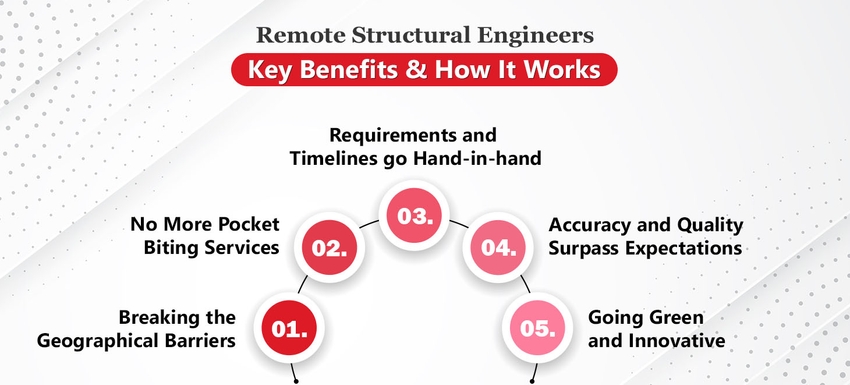
The construction industry is evolving rapidly with technology, digital collaboration, and the increasing adoption of remote engineering services driving the growth. Civil and structural engineers, conventionally preferring physical project sites, are now switching to remote work models to support global construction growth.
The rise of remote Civil structural engineers is one of the most groundbreaking transformations in the construction sector, bridging talent gaps, reducing expenses, and enhancing project efficiency.
With induced sustainability and innovation, remote engineering solutions are revolutionizing how construction sites are perceived and delivered.
The rise of Building Information Modeling (BIM), cloud-based collaboration, and AI-driven project management tools have simplified how engineers contribute to large-scale infrastructure and building projects from anywhere in the world.
The article explores how remote Civil structural engineers are fueling construction growth in 2025 and how businesses can leverage this model for efficiency and innovation.
Challenges in the Construction Industry
The construction industry is still plagued by issues, including scarce skilled labor, rising materials costs, and the increasing demand for green buildings. Civil structural engineers are in huge demand as there are not enough qualified individuals in most locations, thereby leading to delayed and more expensive construction projects.
This labor shortage is also exacerbated by the aging workforce and decreased intake into engineering programs that fail to match industry demand.
Traditional building methods also result in inefficiencies due to huge wastage of materials and labor-consuming manual procedures.
Studies by the World Green Building Council, 2024 have shown that up to 30% of construction materials end up as waste due to inefficiencies and poor site practices. Furthermore, the ecological impact of the sector is of greatest concern, with buildings and infrastructure contributing to nearly 40% of global carbon emissions as per the United Nations Environment Programme.
Greater urgency has never been felt for designing and building innovation with sustainability, and this is driving a migration toward remote-engineering solutions, maximizing resources, and maximizing project efficiency.
Remote Civil Structural Engineers: Decoding the Benefits and Working
Civil structural engineers play pivotal roles in building, bridge, and infrastructure stability design and analysis.
Equipped with remote working capability, the engineers can now contribute to projects anywhere in the world without physically moving to a location, leveraging digital technologies such as BIM and cloud collaboration platforms.

Remote engineering enables firms to access a broader talent pool, optimize resources, and maintain project timelines on schedule with increased efficiency. Enlisted are the benefits of hiring remote civil structural engineers:
Breaking the Geographical Barriers
The ability to hire top engineers from different geographic regions eliminates local skill shortages, enabling companies to incorporate diverse expertise into their projects. Remote professionals often bring advanced technical knowledge and familiarity with cutting-edge engineering software.
No More Pocket Biting Services
Remote engineering reduces overhead costs, including office real estate, utility bills, and relocation expenses.
The majority of companies opt for a ‘pay-as-you-go strategy’, providing flexible fiscal management while having access to high-quality engineering experts.
Requirements and Timelines go Hand-in-hand
With the use of engineers in various time zones, projects can potentially progress 24/7. Computer collaboration tools simplify processes, enabling faster design revisions and reducing choke points.
Accuracy and Quality Surpass Expectations
Off-site engineers use sophisticated structural analysis software to generate precise, high-quality designs that minimize errors and rework. Sophisticated simulation capabilities facilitate more efficient stress testing and material optimization.
Going Green and Innovative
With a focus on eco-friendly construction processes, remote civil structural engineers engage in green solutions such as energy-efficient designs and the use of renewable materials. Their expertise and innovative construction processes help place projects into alignment with green building standards and net-zero construction goals.
Applications of Remote Civil Structural Engineers
Off-site civil structural engineers make prominent site decisions across various industries. Bridge, highway, and dam projects depend on specialized technical expertise in geotechnical and structural design for strength and security.
High-rise and commercial construction employs remote engineering services to deliver enhanced seismic resistance, material efficiency, and digital simulations to optimize structural performance.
Green building development is incorporated through remote engineering solutions with custom and energy-efficient designs.
Moreover, retrofitting and renovation of old buildings become easier through remote engineering analysis, reducing costs and raising safety through premium digital assessments and structural supports.
Overcoming Barriers to Remote Collaboration
Adopting remote engineering entails overcoming challenges such as communication breaks, data security, and workflow coordination.
Companies are increasingly integrating AI-based project management tools, encrypted data transfer platforms, and standardized digital workflows to enable seamless collaboration. Remote working can boost productivity by establishing clear milestones and expectations.
Hiring Remote Civil Structural Engineers with VBS
With Virtual Building Studio, AEC firms can connect with more than 200+ trained engineers from the top 1% of the global talent pool.
The Dedicated Resource Model (DRM) is designed to connect the industry with experts worldwide and deliver exceptional results in terms of quality and precision.
The cost-effective model with tailored professional services is an efficient solution for any firm to thrive and global team expansion.
Future of Construction with Remote Engineers: What to Expect Ahead?
With the construction industry pacing towards digitalization, remote engineering will become the standard choice. Emerging technologies such as AI-driven design automation, digital twin simulations, and augmented reality (AR) for distant site inspections will further enhance efficiency.
The integration of BIM, cloud computing, and IoT-based monitoring systems will enable real-time decision-making, reducing risks and enhancing project outcomes.
Conclusion
An increase in remote recruitment of civil structural engineers is opening up the way to grand developments in the construction sector, eliminating labor shortages, cost inefficiencies, and sustainability concerns.
With the ability to tap into international expertise, the latest technologies, and virtual working platforms, companies can enhance the construction process and remain competitive in the future.
With remote engineering continuing to develop, its influence on the construction future will continue to expand, rendering it an integral component of modern infrastructure development.
Remote civil structural engineering should be embraced by the construction industry in a bid to enhance efficiency, save costs, and produce better quality projects.




